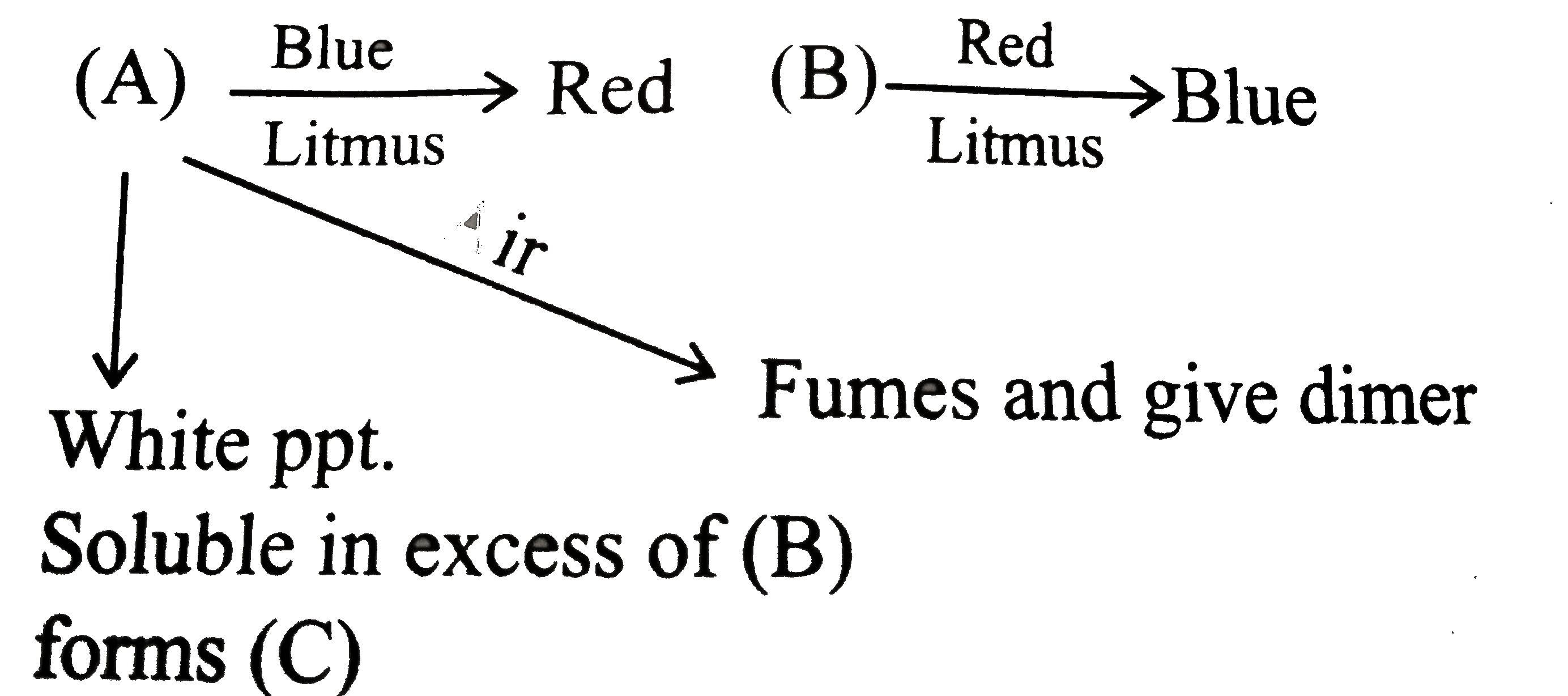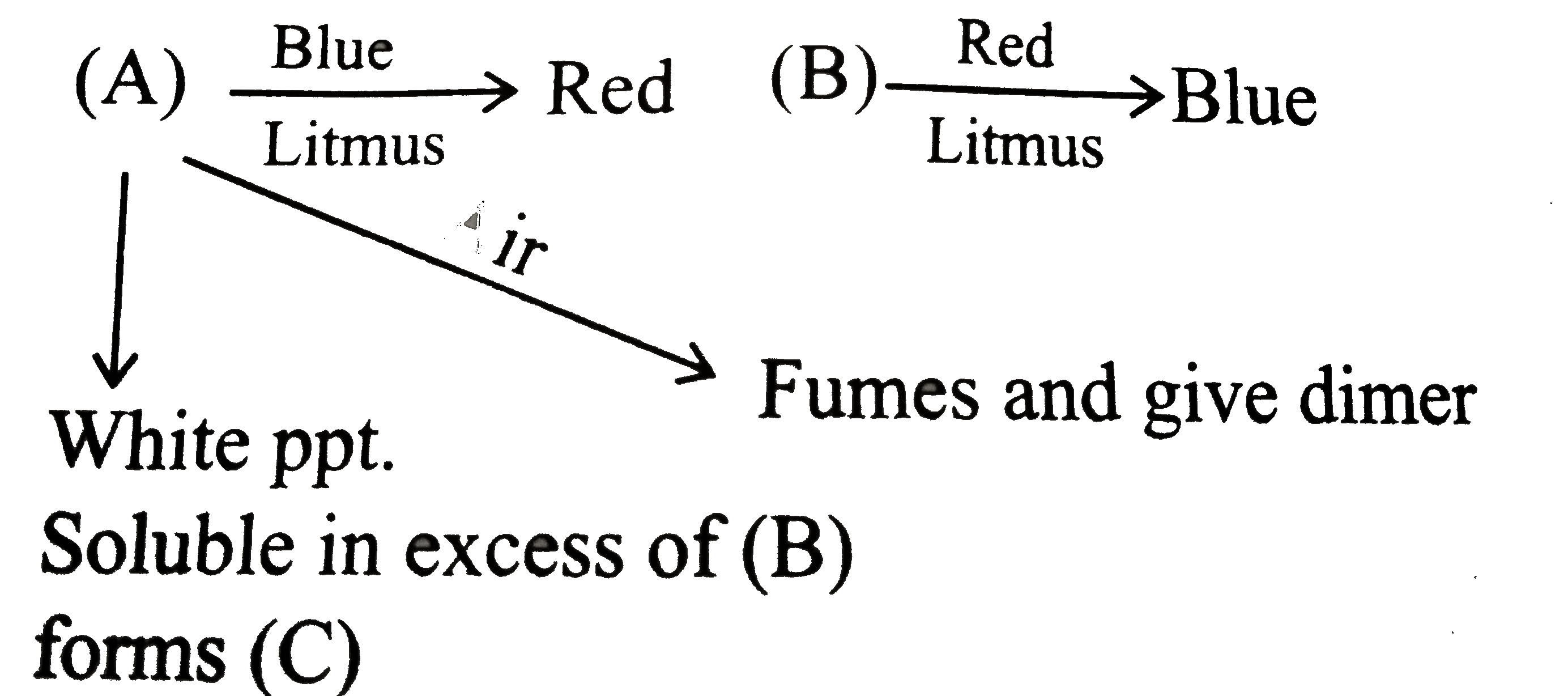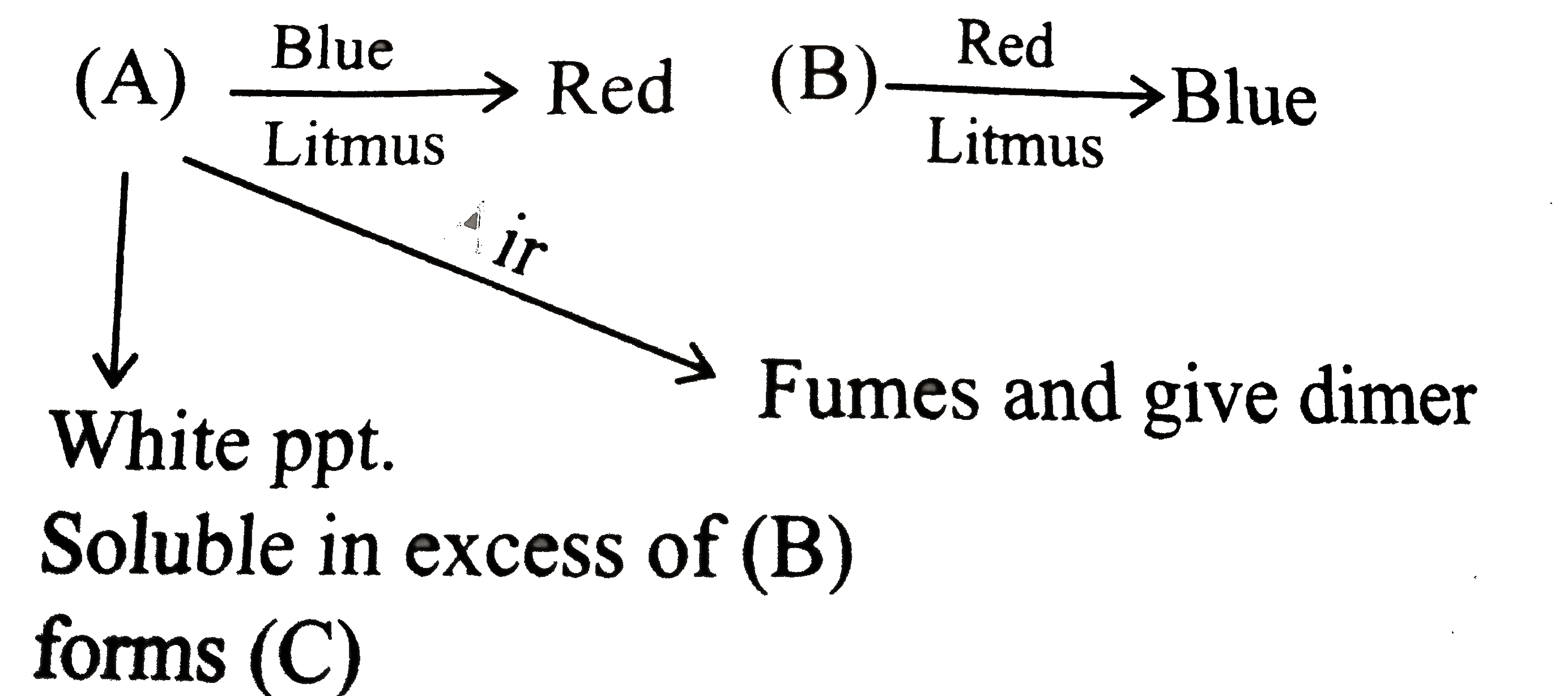On reaction with Cl2 phosphorus forms two types of halides 'A' and 'B'.
Halide 'A' is yellowish- white powder but halide 'B' is colourless oily liquid.
Identify A and B and write the formulae of their hydrolysis products.
To solve the problem, we need to identify the two types of phosphorus halides formed when phosphorus reacts with chlorine and then determine the hydrolysis products of these halides.
1. Identify the Halides:
- When phosphorus (P) reacts with chlorine (Cl₂), it can form two types of halides:
- Halide A: Phosphorus pentachloride (PCl₅), which is a yellowish-white powder.
- Halide B: Phosphorus trichloride (PCl₃), which is a colorless oily liquid.
2. Write the Reaction Equations:
- The formation of these halides can be represented by the following reactions:
- For PCl₅:
P4+10Cl2→4PCl5
- For PCl₃:
P4+6Cl2→4PCl3
3. Hydrolysis of Halide A (PCl₅):
- When phosphorus pentachloride (PCl₅) undergoes hydrolysis, it reacts with water to form phosphoric acid (H₃PO₄):
PCl5+4H2O→H3PO4+5HCl
4. Hydrolysis of Halide B (PCl₃):
- When phosphorus trichloride (PCl₃) undergoes hydrolysis, it reacts with water to form phosphorous acid (H₃PO₃):
PCl3+3H2O→H3PO3+3HCl
5. Final Identification:
- Therefore, we have identified:
- Halide A: PCl₅ (Phosphorus pentachloride) with hydrolysis product H₃PO₄ (Phosphoric acid).
- Halide B: PCl₃ (Phosphorus trichloride) with hydrolysis product H₃PO₃ (Phosphorous acid).
Summary of Answers:
- Halide A: PCl₅ (yellowish-white powder), Hydrolysis product: H₃PO₄
- Halide B: PCl₃ (colorless oily liquid), Hydrolysis product: H₃PO₃
- When phosphorus (P) reacts with chlorine (Cl₂), it can form two types of halides:
- Halide A: Phosphorus pentachloride (PCl₅), which is a yellowish-white powder.
- Halide B: Phosphorus trichloride (PCl₃), which is a colorless oily liquid.
- The formation of these halides can be represented by the following reactions:
- For PCl₅:
P4+10Cl2→4PCl5
- For PCl₃:
P4+6Cl2→4PCl3
- When phosphorus pentachloride (PCl₅) undergoes hydrolysis, it reacts with water to form phosphoric acid (H₃PO₄):
PCl5+4H2O→H3PO4+5HCl
- When phosphorus trichloride (PCl₃) undergoes hydrolysis, it reacts with water to form phosphorous acid (H₃PO₃):
PCl3+3H2O→H3PO3+3HCl
- Therefore, we have identified:
- Halide A: PCl₅ (Phosphorus pentachloride) with hydrolysis product H₃PO₄ (Phosphoric acid).
- Halide B: PCl₃ (Phosphorus trichloride) with hydrolysis product H₃PO₃ (Phosphorous acid).
- Halide A: PCl₅ (yellowish-white powder), Hydrolysis product: H₃PO₄
- Halide B: PCl₃ (colorless oily liquid), Hydrolysis product: H₃PO₃
Topper's Solved these Questions
- BOOK - NCERT EXEMPLAR ENGLISHCHAPTER - P-BLOCK ELEMENTSEXERCISE - Matching The Columns5videos
P-BLOCK ELEMENTS
- BOOK - NCERT EXEMPLAR ENGLISHCHAPTER - P-BLOCK ELEMENTSEXERCISE - Assertion and Reason6videos
P-BLOCK ELEMENTS
- BOOK - NCERT EXEMPLAR ENGLISHCHAPTER - HALOALKANES AND HALOARENESEXERCISE - Long Answer Type Questions3videos
HALOALKANES AND HALOARENES
- BOOK - NCERT EXEMPLAR ENGLISHCHAPTER - POLYMEREXERCISE - Long Answer Type Question5videos
POLYMER
Similar Questions
A compound 'X' which is a yellowish white powder is prepared by the reaction of white phosphours with excess of dry Cl2. Identify 'X'
View SolutionCoSO4Cl.5NH3 exists in two isomeric forms 'A' and 'B'. Isomer 'A' reacts with AgNO3 to give white precipitate, but does not react with BaCl2. Isomer 'B' gives white precipitate with BaCl2 but does not react with AgNO3. Answer the following questions.
(a) Identify 'A' and 'B' and write their structural formulae.
(b) Name the type of isomerism involved.
(c) Give the IUPAC name of 'A' and 'B'.View Solution
Knowledge Check
- Question 1 - Select One
On reaction with Cl2, phosphorus forms two types of halides 'A' and 'B'. Halide 'A' is yellowish-white powder but halide 'B' is colourless oily liquid. What would be the hydrolysis products of 'A' and 'B' respectively?
AH3PO4,H3PO3BHOPO3,H2PO2CH3PO3,H3PO4DHPO3,H3PO3 - Question 2 - Select One
A translucent white waxy solid (A) reacts with excess of chlorine to give a yellowish white powder (B). (B) reacts with organic compounds containing -OH group converting them into chloro derivatives. (B) on hydrolysis gives (C) and is finally converted to phosphoric acid. (A), (B) and (C) are
A1. P4,PCl3,H3PO4B2. P4,PCl5,H3PO3C3. P4,PCl5,POCl3D4. P4,PCl3,POCl3
(a) Name two interhalogens of AB3 type.
(b) Write the hydrolysis product of lC l?View SolutionA liquid 'A' is treated with Na2CO3 solution. A mixture of two salts 'B' and 'C' is produced in the solution. The mixture on acidification with sulphuric acid and distillation produces the liqiud 'A" again. Identify 'A','B' and 'C' and write the equations involved.
View SolutionA colourless mixture of two salts (A) and (B) [excess] is soluble in H2O.

Identify AView SolutionA colourless mixture of two salts (A) and (B) [excess] is soluble in H2O.

Identify BView SolutionA colourless mixture of two salts (A) and (B) [excess] is soluble in H2O.

Identify CView SolutionA complex with molecular formula Co(en)2Cl2 has two isomers A and B '.Isomer 'A' showed a higher dipole moment value Q.Isomer 'A' is
View Solution

